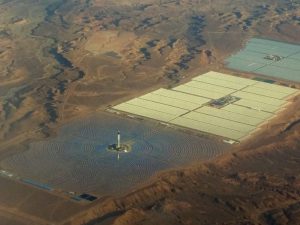Concentrated solar power accounts for only a fraction of the overall green energy market, but recent research suggests smaller-scale designs could help revitalise interest in the sector. We talk to Luis Crespo, president of Protermosolar, Spain’s solar thermal electricity association.

With demand for clean, affordable energy spiking around the world, it may seem counterintuitive to suggest that scaling down concentrated solar power (CSP) operations could help revive the industry.
However, despite the CAPEX costs of building new concentrating solar power plants having fallen by almost 50% between 2013 and 2018, the scale and complexity of such projects remains prohibitively expensive compared with alternatives such as solar thermal towers with storage, solar photovoltaic (PV) or wind projects.
As a result, CSP continues to account for only a fraction of the green energy market and emphasising plant storage value is now seen as key to attracting the investment required to kick-start the sector.
“CSP generation increased by an estimated 8% in 2018,” says the International Energy Agency (IEA). “Nevertheless, CSP is not on track with the Sustainable Development Scenario, which requires annual average growth of almost 26% through 2030.
“Policy design that emphasises CSP plant storage value will be key to attract additional investment.”
It is a view that is shared by Luis Crespo, president of Protermosolar, Spain’s solar thermal electricity association and author of a recent research paper entitled ‘Lateral Thinking on Storage: Getting the Most When it is Empty’.
“The electrical sector is undergoing a period of rapid transition, and planners are only looking at the short-term on how to manage the penetration of competitive but non-dispatchable technologies such as wind and PV,” he states. “CSP is the most competitive renewable technology to replace PV after sunset in sunny countries – the main factor preventing its wide-scale deployment is simply the lack of long-term planning criteria.”
Storage space: optimising CSP night-time storage capabilities
Spain has for decades been at the forefront of efforts to propel solar thermal technology into the mainstream, both domestically and worldwide. The nation’s installed capacity stands at around 2,300MW, while the contribution of Spanish companies in international markets is around 75%.
Crespo agrees with the IEA that optimising CSP’s proven storage capabilities – whereby the solar collector system within the solar power tower, trough or solar dish/engine heats an energy storage unit during the day, and the heat from the storage system is then used to generate electricity in the evening or during cloudy weather – is the way forward for CSP operators and the sector as a whole.
“It makes no sense to generate from CSP plants when the sun shines, as PV is much cheaper,” he explains. “After the sun sets – and the whole night through – there are important demand requirements and there is no other renewable technology that can satisfy this type of demand at lower prices.
“Extending PV production with batteries with 2–3 hours of life will not solve the problem and will end up costing more than double the price of PV systems without batteries during daytime.”
Small wonder: the benefits of modular heliostat fields
One of the most popular CSP technologies, solar power towers, use a large field of flat, sun-tracking mirrors called heliostats to reflect and concentrate sunlight onto a receiver on the top of a tower.
A heat-transfer fluid is then heated and circulated in the receiver and used to produce steam, which is converted into mechanical energy in a turbine, which powers a generator to produce electricity.
However, recent research by Crespo and Francisco Ramos, PhD Physics, director at Nevada Software, concludes that many large-scale power tower plants are inefficient, since the reflected light begins to disperse as it travels across the large distance between the CSP receiver and the heliostat field.
The solution, Crespo and Ramos argue in their research paper ‘Making Central Receiver Plants Modular, More Efficient and Scalable’, is to think small. By dividing a heliostat field into several smaller polar field units that share a single big power block and storage system, developers could potentially realise significant plant efficiency gains.


